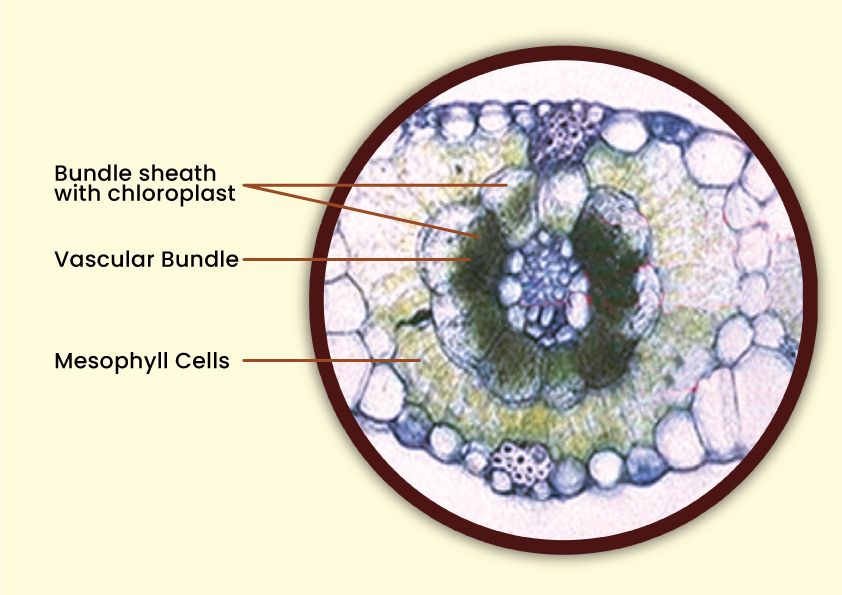
Answer
395.7k+ views
Hint: A dimorphic chloroplast means two structurally different chloroplasts present in one plant. This type of dimorphism is present in plants that carry out a specific type of carbon fixation.
Complete answer:
- Chloroplasts in $C_4$ plants are concentrated in two concentric sheaths of cells around each vascular bundle. The inner sheath of cells is known as the bundle sheath and the outer sheath is the mesophyll sheath.
- In $C_4$ plants, mesophyll cell chloroplasts contain grana and lack in starch while the bundle sheath cell chloroplasts are lacking in grana and are rich in starch. Therefore, the chloroplasts are dimorphic in nature. The bundle sheath cells possess abundant thylakoids which do not stack into grana. Mesophyll sheath cells are similar to $C_3$ plants by showing grana but do not show the presence of starch grains.
- Amaranthus is a $C_4$ plant and thus shows a dimorphic chloroplast.
- $C_4$ fixation requires more ATP than $C_3$ counterparts, hence the plants are able to fix carbon more efficiently in drought, high temperatures, and limitations of nitrogen or ${ CO }_{ 2 }$.
Additional Information: - Flowering plants that carry out $C_4$ carbon fixation belong to the Amaranthaceae, Aizoaceae, Chenopodiaceae, Compositae, Cyperaceae, Euphorbiaceae, Gramineae, Nyctaginaceae, Portulacaceae, and Zygophyllaceae families.
- Another common example of a $C_4$ plant is Maize.
- Grana formation can be induced in bundle sheath cells in plants by manipulating environmental conditions.

So, the correct answer is ‘Amaranthus’.
Note: - $C_4$ carbon fixation is also known as the Hatch–Slack pathway.
- In the first step of carbon fixation in $C_4$ plants, unlike $C_3$ plants whose primary carbon fixation product is 3-phosphoglycerate, oxaloacetate, malate, and aspartate are produced.
- The three types of plants based on carbon fixation are $C_3$, $C_4$, and CAM plants.
Complete answer:
- Chloroplasts in $C_4$ plants are concentrated in two concentric sheaths of cells around each vascular bundle. The inner sheath of cells is known as the bundle sheath and the outer sheath is the mesophyll sheath.
- In $C_4$ plants, mesophyll cell chloroplasts contain grana and lack in starch while the bundle sheath cell chloroplasts are lacking in grana and are rich in starch. Therefore, the chloroplasts are dimorphic in nature. The bundle sheath cells possess abundant thylakoids which do not stack into grana. Mesophyll sheath cells are similar to $C_3$ plants by showing grana but do not show the presence of starch grains.
- Amaranthus is a $C_4$ plant and thus shows a dimorphic chloroplast.
- $C_4$ fixation requires more ATP than $C_3$ counterparts, hence the plants are able to fix carbon more efficiently in drought, high temperatures, and limitations of nitrogen or ${ CO }_{ 2 }$.
Additional Information: - Flowering plants that carry out $C_4$ carbon fixation belong to the Amaranthaceae, Aizoaceae, Chenopodiaceae, Compositae, Cyperaceae, Euphorbiaceae, Gramineae, Nyctaginaceae, Portulacaceae, and Zygophyllaceae families.
- Another common example of a $C_4$ plant is Maize.
- Grana formation can be induced in bundle sheath cells in plants by manipulating environmental conditions.

So, the correct answer is ‘Amaranthus’.
Note: - $C_4$ carbon fixation is also known as the Hatch–Slack pathway.
- In the first step of carbon fixation in $C_4$ plants, unlike $C_3$ plants whose primary carbon fixation product is 3-phosphoglycerate, oxaloacetate, malate, and aspartate are produced.
- The three types of plants based on carbon fixation are $C_3$, $C_4$, and CAM plants.
Recently Updated Pages
Who among the following was the religious guru of class 7 social science CBSE

what is the correct chronological order of the following class 10 social science CBSE

Which of the following was not the actual cause for class 10 social science CBSE

Which of the following statements is not correct A class 10 social science CBSE

Which of the following leaders was not present in the class 10 social science CBSE

Garampani Sanctuary is located at A Diphu Assam B Gangtok class 10 social science CBSE

Trending doubts
Which are the Top 10 Largest Countries of the World?

In what year Guru Nanak Dev ji was born A15 April 1469 class 11 social science CBSE

A rainbow has circular shape because A The earth is class 11 physics CBSE

How do you graph the function fx 4x class 9 maths CBSE

Fill the blanks with the suitable prepositions 1 The class 9 english CBSE

In Indian rupees 1 trillion is equal to how many c class 8 maths CBSE

The Equation xxx + 2 is Satisfied when x is Equal to Class 10 Maths

Why is there a time difference of about 5 hours between class 10 social science CBSE

Difference between Prokaryotic cell and Eukaryotic class 11 biology CBSE




